|
|
Mumbai to Kolkata (A Tour from
India,s West to East)
(26 Days /
25 Nights)
(Bombay -
Nasik - Kopargaon - Aurangabad - Ellora - Ajanta - Mandu - Dhar -
Omkareshwar - Maheshwar - Ujjain - Bhopal - Sanchi - Udaigiri -
Bhimteka - Jhansi - Orchha - Khajuraho - Varanasi - Sarnnath - Calcutta
- Bardhaman - Shantiniketan - Kolkata)
(to view the route of this tour on a Map please click
here)
|
|
|
|
Day
01. Flight to India (Mumbai)
Around Midnight arrive in Mumbai
(formerly known as Bombay). The cosmopolitan City and capital of
Maharashtra is the main gateway for the travelers to
India. Upon
arrival, you will be met by an Indo Vacations representative and
transferred to the hotel.
Day 02. Mumbai: Excursion
After having our breakfast we have sightseeing in Mumbai. Today in our
sightseeing we visit the Gandhi Museum, Hanging Garden, City Museum,
Marine Drive Flyover, St. Thomas Cathedral, Chhatrapati Shivaji
terminus, Rajabai Tower, Kamala Nehru Park, Hanging Gardens, Mumbai
University, High Court, Oval Maidan and Gateway of India. We have a
walk through the harbor area and visit the Gateway of India built in
1927 to commemorate the visit of George 5th from England. We have a
Boat Ride at Gateway of India. In the afternoon we visit the laundry
people on the shore (Dhobi Ghat) and later we will also learn about
the art of Dabbawalas. A dabbawala is a person who is part of a
delivery system that collects hot food in lunch boxes from the
residences of workers in the late morning, delivers the lunches to the
workplace by various modes of transport, mostly bicycles and the
railway trains, and returns the empty boxes back to the customer's
residence that afternoon. They are also made use of by prominent meal
suppliers in Mumbai where they ferry ready, cooked meals from central
kitchens to the customers and back. Then we proceed to Mani Bhawan
Museum. |
|
|
|
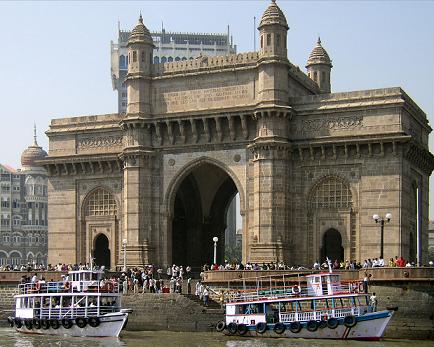 |
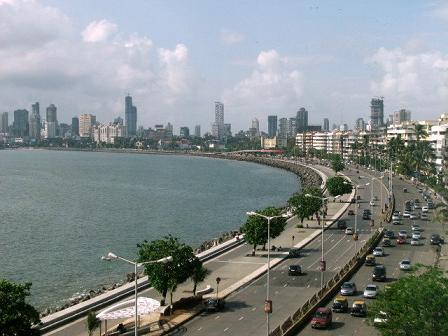 |
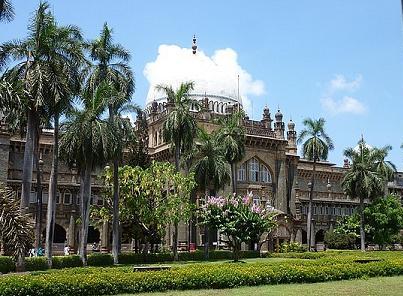 |
|
Gateway of
India |
Marine Drive |
Prince of Wales
Museum |
|
|
Day 03. Mumbai/Bombay - Nasik (about 165 km / 3˝ hrs)
Today we drive from Mumbai to Nasik. The region surrounding
Nasik is the center of wine
production in India. But Nasik is also an emerging industrial city of
many national and international companies which have branches in
Nashik. Rest of the time free for leisure at the hotel.
Day 04. Nasik
Today we visit Pandu Lena, about 8 km south-west of Nasik, near the
Bombay Road, there are 21 Buddhist Hinayana caves of Pandu Lena. They
date from 1st century BC to the 2nd century AD. Then we visit Sundar
Narayan Temple which is situated near Ramkund, it is visited for its
heritage character and architectural style of temples. Then we proceed
to visit Sita Gumpha Cave. Sita Gumpha is a place from where Sita was
kidnapped by the demon king Ravana. After this we visit Trimbakeshwar
temple which is about 25 kms from Nasik. |
|
|
|
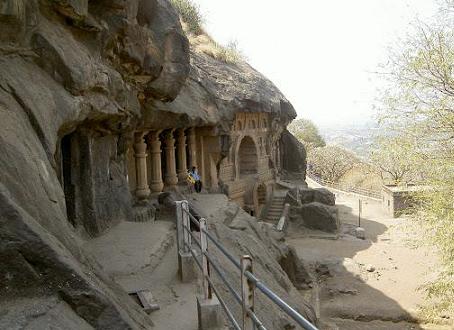 |
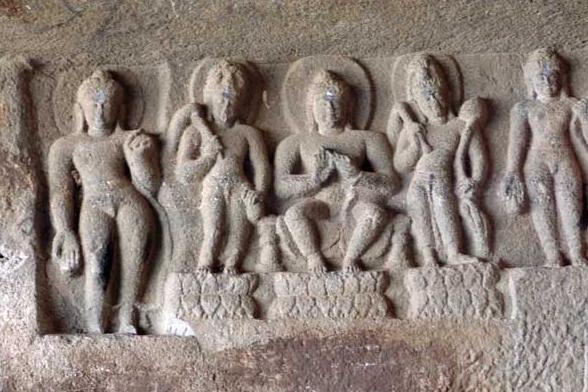 |
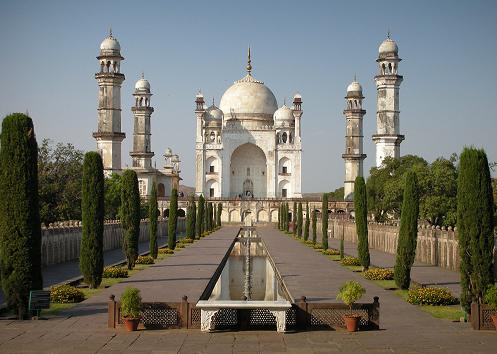 |
|
Pandu Lena
Caves |
Pandu Lena
Caves |
Bibi Ka Maqbara
Aurangabad |
|
|
Day
05. Nasik - Kopargaon - Aurangabad (about 185 km / 4 hrs)
Today we drive to Aurangabad. Arrival in
Aurangabad. We vist the famous
water mill complex which dates back to 17th century. We also visit
Bibi Ka Maqbara, a replica of the famous
Taj Mahal. Bibi Ka Maqbara is
located on the bank of the river. The rest of the day is at leisure.
Day 06. Aurangabad: Excursion Ellora
Today we have excursion Ellora. Ellora is famous for its caves and
cave temples and monasteries. Ellora
Caves dates back between 7th - 10th century A.D. The
magnificent group of rock temples of Ellora is a part of world
heritage monuments. Ellora group of temples represents the art and
sculptures of Buddhism,
Hinduism and
Jainism - three dominant religions of India. After sightseeing
we drive back to Aurangabad
Day 07. Aurangabad Excursion Ajanta
After the breakfast we drive through the cotton-growing area to
Ajanta caves (UNESCO Heritage Site).
Of the thirty monuments at Ajanta, four caves No 9, 10, 26 and 29 are
sanctuaries or Chaitya containing a Stupa at the centre of their
apses. The rest are monastic residences or Viharas. An Indian poet
Kalidasa describes these caves as the gem set of jewellery, rich
furniture, imposing architecture, natural scenery and fleeting
expressions on the faces. |
|
|
|
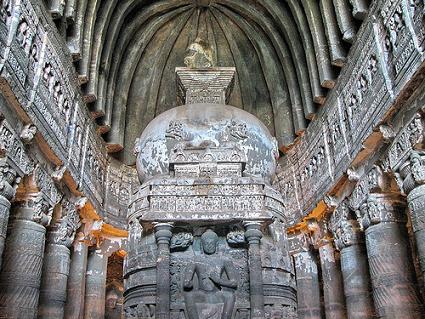 |
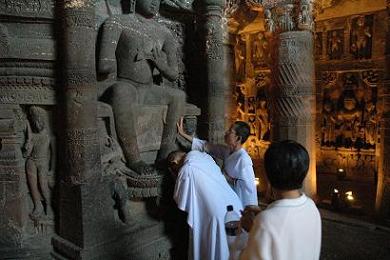 |
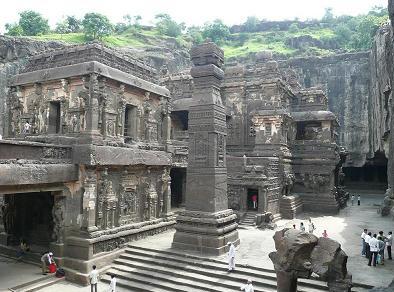 |
|
Ajanta Caves |
Buddha Stupa
Marc Shandro |
Ellora Caves
Mountain Temples |
|
|
Day 08. Aurangabad - Mandu (about 350 km)
Today we drive to Mandu. (in the Middle Ages Mandu is also known as
the "City of Joy"). Mandu is situated about 90 kms from
Indore. Mandu,
also known as Shadibad, which means the city of joy. Mandu was
fortified as early as the 6th century, but gained prominence in the
10th century as the fort capital of the Parmar rulers of Malwa. Mandu
is perched along the Vindhyan ranges at 592 m. The rest of the day is
at leisure.
Day 09. Mandu - Dhar - Mandu (about 80 km)
Today we have sightseeing in Mandu. We visit Jahaz Mahal, a palace
shaped like a ship that floats serenely on the bosom of the lake, Its
shape and kiosks looks like a heavenly ship sailing into eternity, it
is very famous place of Mandu. After this we visit Hindola Mahal,
Champa Baoli, Jami Masjid, Hoshang Shah’s Tomb, Rewa Kund (Palace of
Baz Bahadur), Roopmati Pavilion. After the sightseeing of Mandu we
have an excursion to Dhar.
Dhar: Dhar is situated about 35 km from Mandu. Dhar was the capital of
the Parmar kings. It was later conquered by Muslims. Dhar was founded
by Raja Bhoj. The monuments here are a combination of Hindu, Afghan
and Mughal architecture. We have a good view of the city from the
ramparts of the well-preserved forts. . In the large stone mosque (Bhojashala)
you can admire Sanskrit inscriptions. Next to the mosque is the grave
of the Muslim saint Kamal Maula. After the sightseeing we dribe back
to mandu.
Day 10. Mandu - Omkareshwar - Maheshwar - Mandu (about 220 km / 5
hrs)
Today we have excursions to Omkareshwar and Maheshwar.
Omkareshwar: Omkareshwar is situated about 77 km. from Indore.
It is an important place of pilgrimage. It is a sacred island shaped
like the holy Hindu symbol ‘Om’ in the middle of the Narmada, which
has drawn pilgrims for centuries. The island is over 2 km long and 1
km wide and is divided from north to south by a deep gully. The Omkar
Mandhata temple is situated at the eastern end of the island. This
temple is dedicated to the Lord Shiva. This temple is one of the
twelve Jyotirlinga in India, a natural rock feature that is believed
to be representations of Siva in the form of a linga. This temple has
beautiful carvings.
Maheswar: Maheshwar is situated about 91 km. from Indore.
Maheshwar is situated on the northern banks of the Narmada river.
Maheshwar has been identified as Mahishmati, the ancient capital of
King Kartivirarjun. This ancient town is mentioned in the Ramayana and
the Mahabharata and revived by Ahilya Bai, the Holkar queen of Indore.
This town is also known throughout India for its Maheshwar saris.
Maheshwar has beautiful temples and a fort complex. The temples and
fort complex are reflected quietly in the river flowing below. The
temples which can be seen in Maheshwar are Kalshwara, Rajarajeshwara,
Vithaleshwara and Ahileshwar. After the sightseeing we drive back to
Mandu.
|
|
|
|
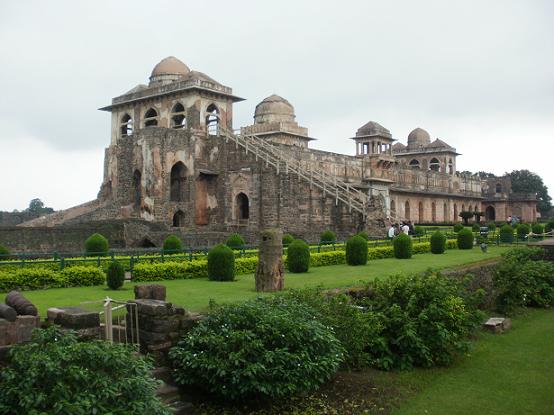 |
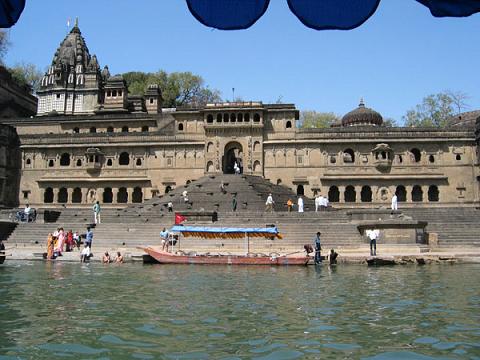 |
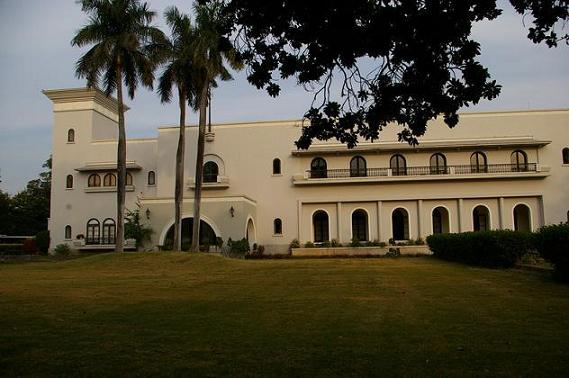 |
|
Mandu:
Jahaj Mahal |
Indore
Maheshwar |
Dhar
Jhira Back |
|
|
Day 11. Mandu - Ujjain (about 145 km)
Today we drive to Ujjain. Ujjain is
one of the greatest cities of ancient India and one of the seven
sacred cities of Hindus in India. It is also one of the four towns
where the Kumbh Mela is held and plays as a host up to a million
pilgrims who gather on the place every twelve years. The city has had
a long and distinguished history. According to legend, the gods and
the demons once churned the ocean for Kumbha (a pot of divine nectar).
First emerged a pot of vish or poison. The Lord Shiva drank it down.
The poison was so strong that his divine neck turned blue and he was
known as the Nilkantha or the blue-necked one. It all happened at
Ujjain and that is the reason for its sacredness. Rest of the day at
leisure.
Day 12. Ujjain
Today we have sightseeing Tour of Ujjain. We visit the famous temple
of Ujjain. Mahakaleshwar Temple, Mahakaleshwar Temple with its soaring
Shikhar (tower) dominates the skyline and life of Ujjain. This temple
is dedicated to Lord Shiva and houses the lingam of Lord Shiva. This
temple is also an important pilgrimage centre for Hindus. This temple
is one of the 12 Jyotirlingas in India, and believed to be swayambhu
(born of itself), deriving its Shakti or power from within itself.
Bade Ganeshji Ka Mandir, located close to the tank near Mahakaleshwar
Temple. This temple enshrines a large sculpted image of Ganesh.
Kaliadeh Palace, is situated about 8 km from the city centre. The
Kaliadeh Palace is built on the banks of the Shipra river. This once
imposing building was built by Mahmud Khilji in 1458. Akbar stayed
here in 1601.
Day 13. Ujjain - Bhopal (about 192 km)
Today we drive to Bhopal. Bhopal is
the capital of Madhya Pradesh
which was founded by Raja Bhoj in 11th century. Bhopal is known as the
city of lakes. Upon arrival in Bhopal, you will be met by an Indo
Vacations representative and transferred to the hotel. In the evening
we have sightseeing in Bhopal. We will visit Taj -ul- Mosque, Birla
Museum, Laxmi Narayan Temple, Gandhi Bhawan and also enjoy the boat
ride in the lake. Then apply drive to the Bhimteke caves. |
|
|
|
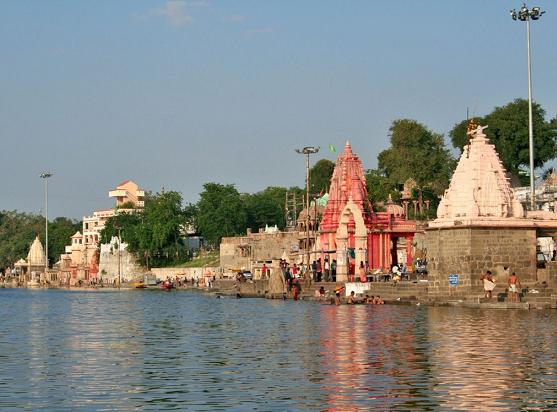 |
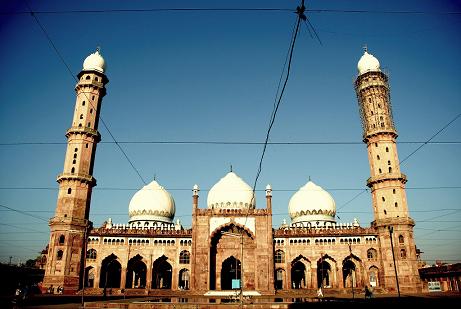 |
 |
|
Ujjain |
Bhopal Tajuldin
Mosque |
Sanchi Stupas
Western gateway |
|
|
Day 14. Bhopal: Excursion Udaigir and Sanchi
Today we have excursion to Sanchi
(UNESCO Heritage Site) and Udaigiri. Stupa of Sanchi is one of the
oldest stone structure. The construction work of this stupa was look
after by Ashoka's wife, Devi herself, who was the daughter of a
merchant of Vidisha. Sanchi was also her birthplace and also the venue
of her and Ashoka's wedding.The Udayagiri Caves are a Hindu tradition
site which are situated near Vidisha in Madhya Pradesh. They were
decorated properly and reworked under the command of Chandragupta II,
Emperor of the Gupta Empire, in the late 4th and 5th century CE.
Udayagiri Caves are most important archaeological sites from the Gupta
period and are presently a tourist site under the protection of the
Archaeological Survey of India.
Day 15. Bhopal - Bhimbetka - Bhopal (about 95 kms)
Today we take an excursion to Bhimbetka. Bhimbetka is an
archaeological place in the Indian state of
Madhya Pradesh. It is
included in UNESCO World Heritage Site. Bhimbetka Hill has the richest
collection of prehistoric paintings associated with many other
archaeological discoveries. The site was discovered by V.S. Wakanker
of the Vikram University, Ujjain, in 1957 and systematic digging at
the site has continued since 1971. The hill is located in the middle
of a dense deciduous forest and there are over 30 species of trees
with edible fruit, flower seeds and tubers. There is also still a rich
wildlife including several species of deer, wild boar, sloth bear,
antelope, leopard, jackal, scaly anteater and a wide range of species
of birds. Perennial springs provide the essential year round water
supply. In this place, over 700 caves with Neolithic rock-paintings
have been discovered. The oldest paintings are at least as old as
those of the Pyrenees. Over 500 caves contain prehistoric and later
paintings and a smaller number have evidence of Stone Age habitation
from the Lower Palaeolithic period to the late Mesolithic. Some of the
cave paintings are quite small, while some are about 10 metres long.
Red and white are the dominant colours used, but green and yellow are
also found. The paintings belongs to three periods. The prehistoric
phase is dominated by wild life paintings of cattle, boar, tiger, deer
engaged in various activities, and varies from tiny miniatures to life
size and often life-like representation. Hunting is a common theme,
the humans during this period being shown simply as “stick men”. Some
women are shown, occasionally pregnant. In the transitional period,
men are shown grazing or riding animals, but animals lose their
proportions and naturalism. The later period is quite different, and
animals and animal hunts are replaced by battle scenes with men riding
on elephants and horses with spears, bows and arrows and probably date
from the early centuries AD. Bhimbetka is designed as a place of
residence of the hero Bhima of Indian epic
Mahabharata, Bhimbetka was
first mentioned in Indian archeological records based on information
from local tribal people as a Buddhist site. After sightseeing we
drive back to Bhopal. |
|
|
|
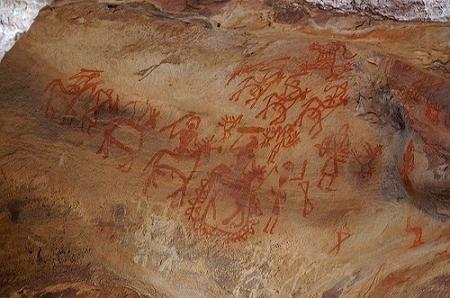 |
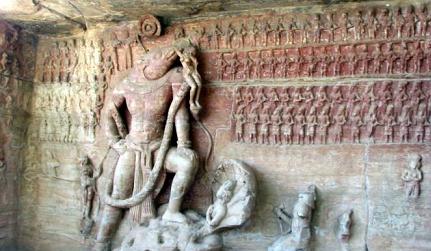 |
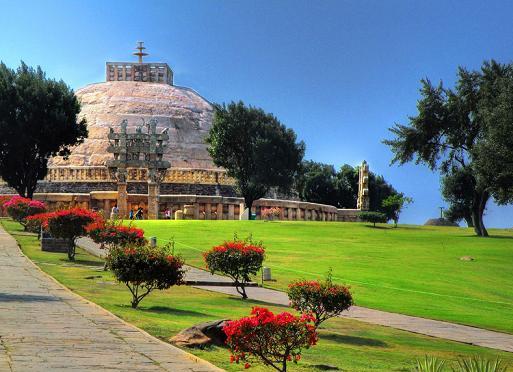 |
|
Bhimbetka |
Udaigiri Madhya
Pradesh |
Sanchi Stupas |
|
|
Day 16. Bhopal - Jhansi (per zug) - Orchha (about 17 km)
After breakfast drive to Bhopal railway station for train to
Jhansi. The place Jhansi has a turbulent
history. Most tourists come here only because it is a convenient
starting point for a trip to Khajuraho. Arrival in Jhansi and
transferred to hotel in Orchha.
Arrival in Orchha in the afternoon. Rest of the day at leisure.
Day 17. Orchha
Orchha's grandeur has been captured in stone, frozen in time, a rich
legacy to the ages. In this medieval city, the hand of time has rested
lightly and the palaces and temples built by its Bundela rulers in the
16th and 17th centuries retain much of their pristine perfection.
In the morning we visit the temples and palaces in Orchha. We visit
the Jehangir Mahal Palace, Raj Mahal whose wall paintings have depict
beautiful natural scenes and motifs. Then we visit the Ram Raja Temple
which is the main temple of Orchha. It dates from the 16th century and
is visited by thousands of visitors regularly. In the temple there is
a statue of the god Rama which once brought from the wife of the ruler
of Bundela of the pilgrimage from Ayodhya.
Day 18. Orchha - Khajuraho (about 172 km)
In the morning we drive to Khajuraho.
Khajuraho was the capital of the Chandela dynasty. The Chandela Kings
claimed descent from the moon. The temples of Khajuraho are among the
finest examples of temple craftsmanship in the whole of India. The
rest of the day at leisure. Best known is the Laksman Temple,
dedicated to Lord Vishnu and whose input the holy trinity of Brahma,
Vishnu and Mahesh is ready.
Day 19. Khajuraho - Varanasi (by air)
Today we visit the temple complex of
Eastern Group
and Western Group
to see the most beautiful temples in
India. The temples of Khajuraho are considered the epitome of
Hindu architecture and sculpture art. Most famous among them is the
Laxmana Temple which is dedicated to god Vishnu. The presence of
erotic sculptures in the Temples at Khajuraho is one of the expression
among others of the celebration of all human activities displaying
different aspects of Hinduism. Then
we have flight to Varanasi.
Arrival in Varanasi. The rest of the day at leisure. Varanasi is
without doubt India’s most sacred city and thus visited by over one
million people. Varanasi is also called the city of light.
Buddha visited this city in 500 BC. In
the evening drive to the banks of the river Ganges to experience
prayer ceremony. |
|
|
|
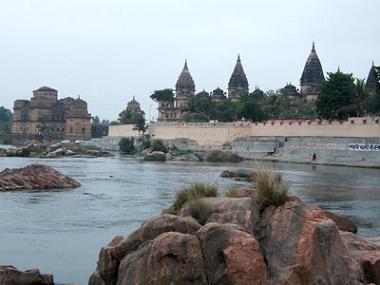 |
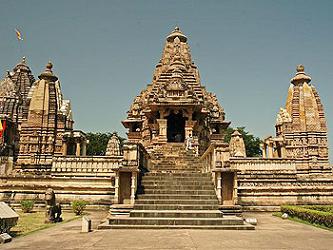 |
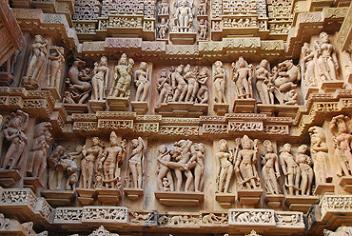 |
|
Orchha |
Laxaman Temple
Khajuraho |
Ueberwaeltigend
Khajuraho Tempel |
|
|
Day 20. Varanasi
In the early morning we take a boat ride on the
Holy River Ganges and enjoy sunrise
on the boat. Ghats (flight of
steps) and the activities of pilgrims on that are the principal
attraction for visitors to Varanasi. Thousands of pilgrims and
devotees visit this city to make holy prayers, to meditate and to
purify themselves through taking a bath in the holy river Ganges. In
the noon we visit the city of Varanasi.
After visit in Varanasi we drive to
Sarnath (10 km). Sarnath is the place where Buddha delivered
his first sermon at deer park.
Day 21. Varanasi - Calcutta (by train)
Today you will be transferred to railway station for overnight train
journey to Kolkata. |
|
|
|
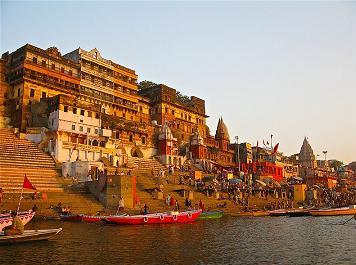 |
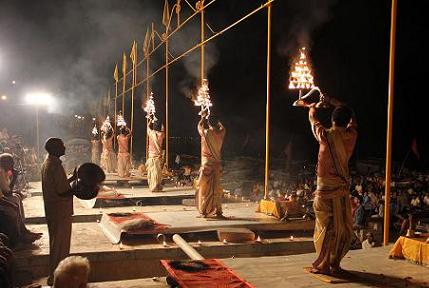 |
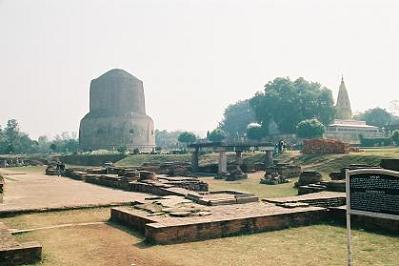 |
|
Gangaghat
Varanasi |
Ganga Aarti
Varanasi |
Sarnath
Varanasi |
|
|
Day
22. Kolkata (Calcutta)
Arrival in Kolkata. Upon arrival in Kolkata you will be transferred to
the hotel. Kolkata is the
cosmopolitan city and capital of
West Bengal. Kolkata is the largest city of India. Kolkata is an
extraordinarily vibrant and lively city. This city was once the
colonial city of British in India. Today we explore this vibrant and
lively city. We will visit the Victoria Memorial and magnificent
buildings in the area of Chowringhee and Dalhousie Square. We will
also visit the Jain-Temple and the Fort Williams. In the area of
Joransanko we have the opportunity to visit the family house of the
famous Indian writer Rabindranath Tagore.
Day 23. Kolkata - Shantiniketan (about 200 km / 05 hrs)
Today we drive to Shantiniketan.
Shantiniketan was founded by Maharishi Debendranath Tagore,
father of Rabindranath Tagore, who also established an ashram here,
later known as the Abode of Peace. In 1901, his son started an
experimental place of learning with a classroom under the trees and a
group of five pupils. This place later became to be known as Vishva
Bharati University in 1921 which attracts students from all over the
world and aspires to be a spiritual meeting ground in a serene,
culturally rich and artistic environment. Today, Shantiniketan is a
great centre for higher studies in arts and known for the famous
Vishva Bharati University. The whole place is steeped in the memory of
the great poet, Rabindranath Tagore.
Day 24. Shantiniketan
Today we spend whole day in Santiniketan. We visit the Vishva Bharati
University which was was founded by Rabindranath Tagore in 1921. Then
we visit Uttarayan Complex where the poet, Rabindranath Tagore lived
consists of several buildings in a distinct architectural style. After
this we proceed to Sriniketan, situated about 3 km. away from
Shantiniketan. It is a sister institute and dedicated to rural
development programmers.
|
|
|
|
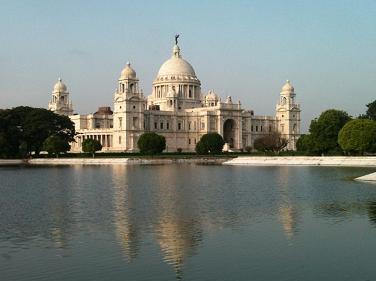 |
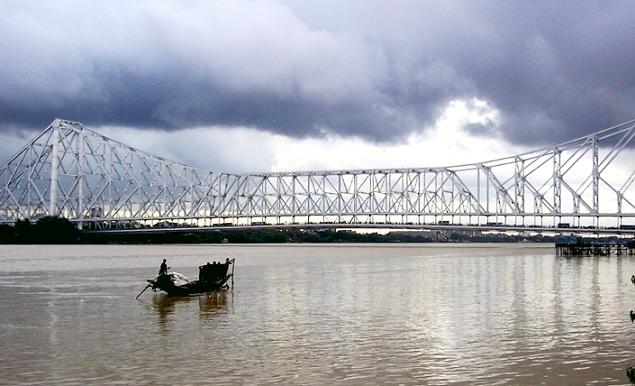 |
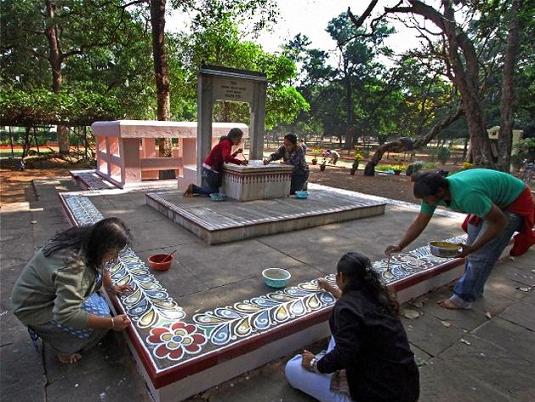 |
|
Calcutta
Victorial Memorial |
Howrah Bridge |
Vishva Bharati
University |
|
|
Day 25. Shantiniketan - Kolkata (about 200 km / 05 hrs)
In the morning we drive from Shantiniketan to Kolkata. The rest of the
day is at leisure
Day 26. Flight to Home Destination
Today, the day is today at leisure. You have to checkout from the
hotel up to 12.00 am. Depending on your departure time you will be
transferred to Airport / Railway station for onwards journey.
(End of
Tour)
|
|
|
|
Tour
Reservation
To get more
information or to book this tour please submit the
Query Form
or send us an
E-Mail ! Your
booking will be activated only after we get a reconfirmation from
your side.
About Hotels:
We provide you the accommodation as per your budget mentioned above
in the table of hotels category for any of the booked tour. Hotels
provided by us are from budget to luxury class hotels. The criteria
for selecting hotels by us remains the best value of your money. We
also provide you wherever possible accommodation in heritage hotels.
Heritage Hotels are old Palaces, Forts and Grand mansions of
Maharajas which have been later renovated and converted into Hotels.
Rooms are decorated all individually. Rooms are comfortable,
romantic and present the flair of olden Maharaja days.
|
|

